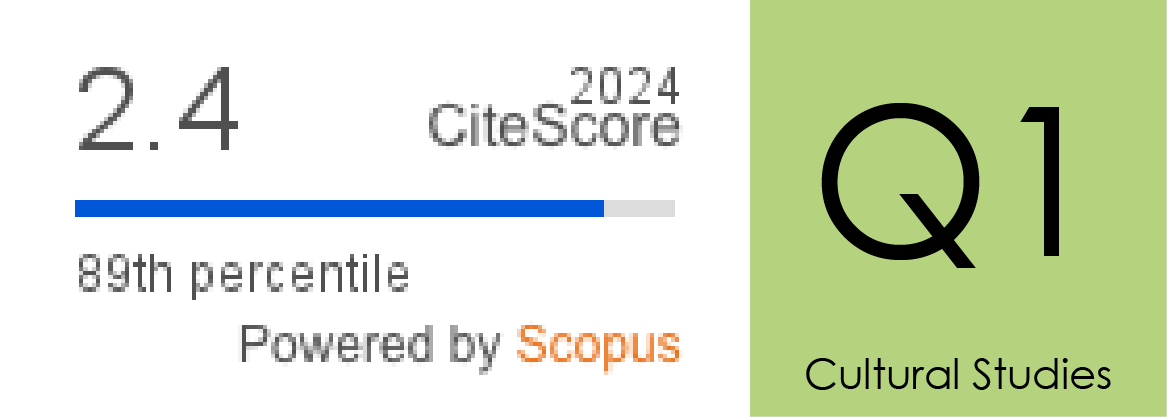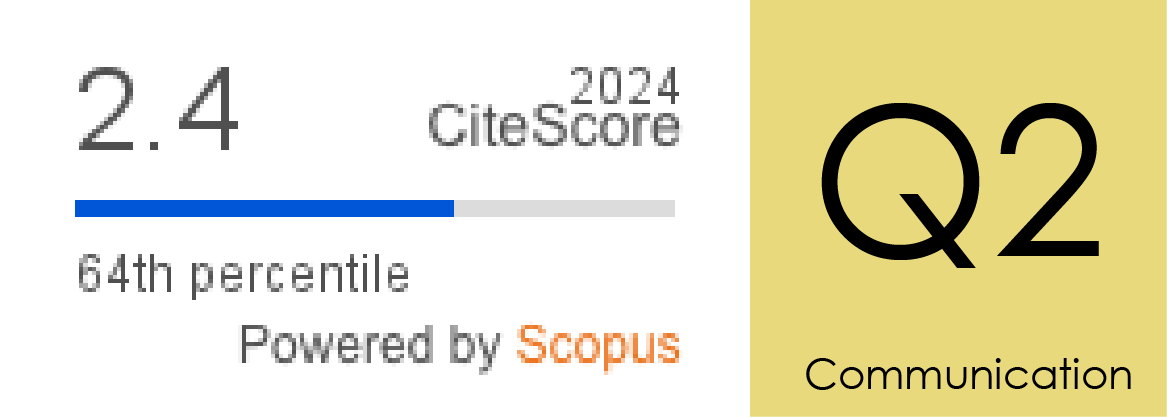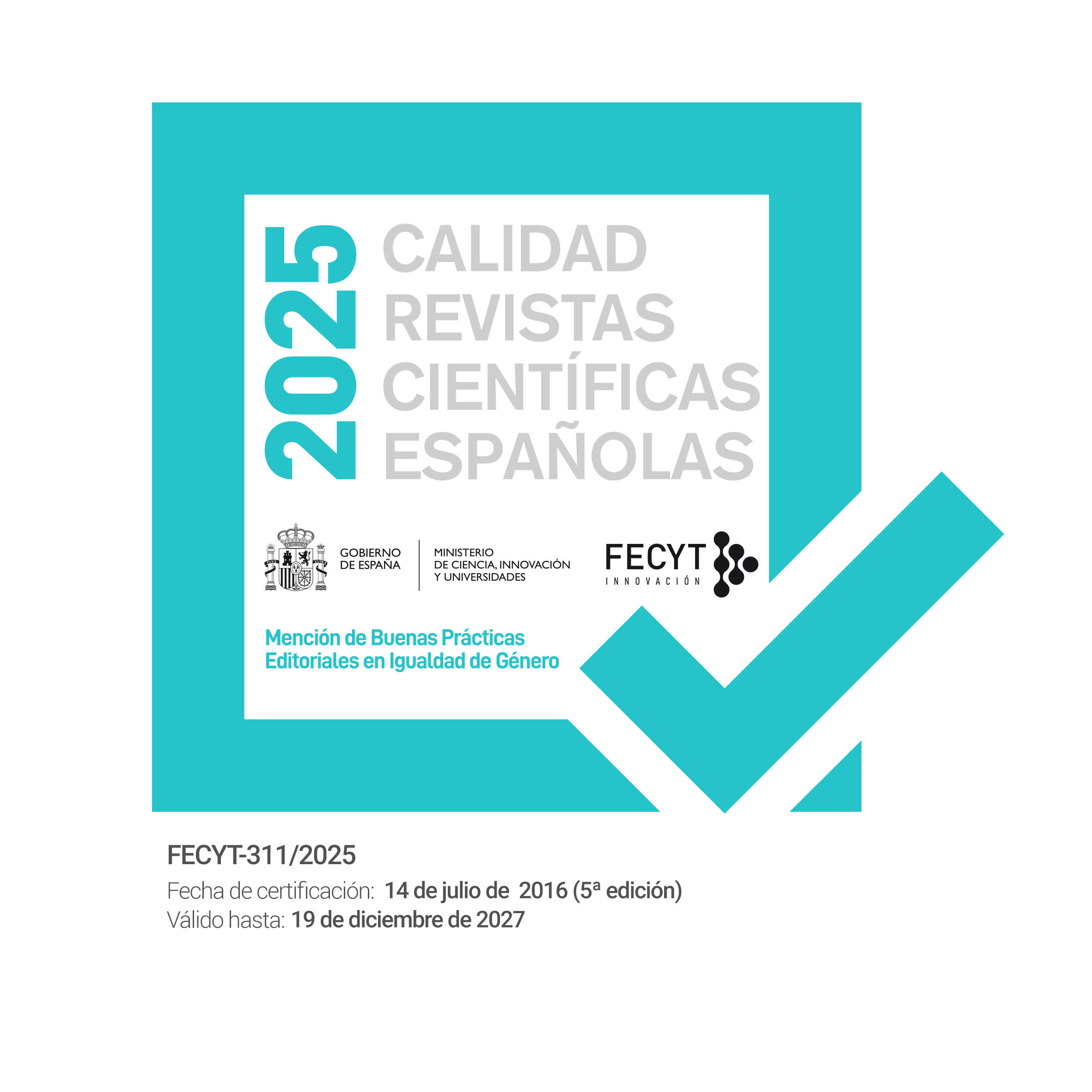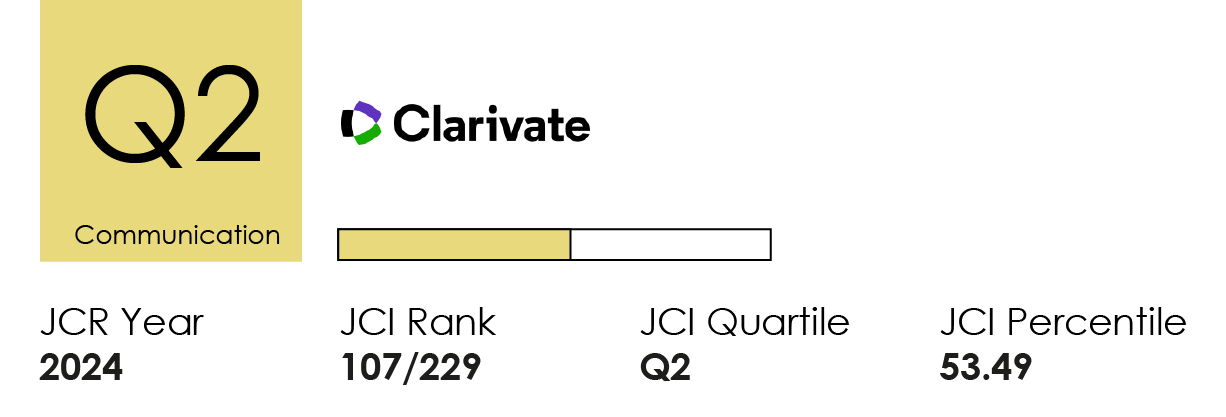Comunicar los ODS para crear conciencia ciudadana: un análisis de la actividad de la Administración Pública en Twitter
DOI:
https://doi.org/10.14198/MEDCOM.24107Palabras clave:
Administración Pública, Agenda 2030, desarrollo sostenible, engagement, ODS, Twitter.Resumen
La investigación analiza la comunicación en Twitter por parte de la Administración Pública en torno a los Objetivos de Desarrollo Sostenible (ODS) a través de la metodología del Análisis de Redes Sociales (ARS) y de la estadística, analizando el índice de interacción, la polaridad y la objetividad de los mensajes, descubriendo que todos los usuarios están conectados entre sí de alguna manera y que las comunidades de usuarios se establecen en torno al ámbito geográfico en donde destacan, además de las cuentas de ámbito nacional, las comunidades autónomas de Cataluña, Castilla-La Mancha, Extremadura y Aragón. En cuanto a los tuits que tratan los ODS, son escasos en volumen con respecto del total de publicaciones, siendo más objetivos que los que tratan otros temas, aunque no existen diferencias en el engagement o en la polaridad. Los políticos desde sus cuentas individuales generan mayor engagement y publican mensajes más positivos que las cuentas de ámbito nacional o regional, de la misma forma que los tuits de esta última categoría de cuentas son más objetivos. Los tuits con elementos multimedia complementarios o enlaces añadidos logran un índice de interacción más alto. Por todo lo anterior, la investigación permite que la Administración Pública pueda definir de forma eficiente su comunicación en Twitter relacionada con la Agenda 2030 a través de tuits publicados desde las cuentas individuales de los responsables de las instituciones, incluyendo elementos multimedia o enlaces a contenidos complementarios y con un sentimiento positivo y un contenido relativamente subjetivo.
Citas
Annesi, N., Battaglia, M., Gragnani, P., & Iraldo, F. (2021). Integrating the 2030 Agenda at the municipal level: Multilevel pressures and institutional shift. Land Use Poblicy, 105. https://doi.org/10.1016/j.landusepol.2021.105424
Apuke, O. D., & Omar, B. (2021). Fake news and COVID-19: modelling the predictors of fake news
sharing among social media users. Telematics and Informatics, 56. https://doi.org/10.1016/j.tele.2020.101475
Canel, M. J. (2021). Public Communication and Sustainability in a Post-Truth Era. In L. Corredoira, I. Bel, & R. Cetina (Eds.), The Handbook of Communication Rights, Law, and Ethics: Seeking Universality, Equality, Freedom and Dignity (pp. 265-278). John Wiley & Sons, Inc. https://doi.org/10.1002/9781119719564.ch22
Carrasco-Polaino, R., Sáchez-de-la-Nieta, M. Á., y Trelles-Villanueva, A. (2020). Las elecciones al parlamento andaluz de 2018 en Instagram: partidos políticos, periodismo profesional y memes. Revista Mediterránea de Comunicación, 11(1), 75. https://doi.org/10.14198/MEDCOM2020.11.1.19
Carrasco-Polaino, R., Villar-Cirujano, E., y Martín-Cárdaba, M.-Á. (2019). Redes, tweets y engagement: análisis de las bibliotecas universitarias españolas en Twitter. El Profesional de La Información, 28(4). https://doi.org/10.3145/epi.2019.jul.15
Casero-Ripollés, A. (2019). Servicios móviles de mensajería instantánea y Covid-19: oportunidades y limitaciones para la comunicación institucional. Anuario ThinkEPI, 14. https://doi.org/10.3145/thinkepi.2020.e14d05
Clauset, A., Newman, M. E. J., & Moore, C. (2004). Finding community structure in very large networks. Physical review E, 70(6). https://doi.org/10.1103/physreve.70.066111
Criado, J. I., & Rojas-Martín, F. (2013). Social media and public administration in Spain: a comparative analysis of the regional level of government. In R. Gil-Garcia (Ed.), E-government success around the world: Cases, empirical studies, and practical recommendations (pp. 276-298). IGI Global. https://doi.org/10.4018/978-1-4666-4173-0.ch014
Eggers, W.D. (2004). Government 2.0: Using technology to improve education, cut red tape, reduce gridlock, and enhance democracy. Rowman & Littlefield.
Eurostat. (2022a). Sustainable Development in the European Union: Overview of Progress Towards the SDGs in an EU Context (2022 Edition). Publications Office of the European Union. http://bitly.ws/BBwu
Eurostat. (2022b). SDG country overview. http://bitly.ws/BByA
Feeney, M. K., & Porumbescu, G. (2021). The limits of social media for public administration research and practice. Public Administration Review, 81(4), 787-792. https://doi.org/10.1111/puar.13276
Filippo, D., Benayas, J., Peña, K., & Sánchez, F. (2020). Communication on Sustainability in Spanish Universities: Analysis of Websites, Scientific Papers and Impact in Social Media. Sustainability, 12(19), 8278. https://doi.org/10.3390/su12198278
García-Sánchez, I. M., Amor-Esteban, V., & Galindo-Álvarez, D. (2020). Communication strategies for the 2030 agenda commitments: A multivariate approach. Sustainability, 12(24), 10554. https://doi.org/10.3390/su122410554
Gobierno de España. (2018). Plan de acción para la implementación de la Agenda 2030. Hacia una estrategia española de Desarrollo Sostenible. https://cutt.ly/JV32i5x
Grover, P., Kar, A.K., Gupta, S., & Modgil, S. (2021). Influence of political leaders on sustainable development goals – insights from twitter. Journal of Enterprise Information Management, 34(6), 1893-1916. https://doi.org/10.1108/JEIM-07-2020-0304
Gunawong, P. (2015). Open government and social media: A focus on transparency. Social Science Computer Review, 33(5), 587-598. https://doi.org/10.1177/0894439314560685
Hand, L. C., & Ching, B.D. (2011). "You Have One Friend Request" An Exploration of Power and Citizen Engagement in Local Governments' Use of Social Media. Administrative Theory & Praxis, 33(3), 362-382. https://doi.org/10.2753/ATP1084-1806330303
Hansen, D., Shneiderman, B., & Smith, M. A. (2010). Analyzing Social Media Networks with NodeXL: Insights from a Connected World. Morgan Kaufmann.
Herbst, S. (2011). (Un)numbered voices? Reconsidering the meaning of public opinion in a digital age. En K. Goidel (Ed.), Political polling in the digital age (pp. 85-98). Louisiana State University Press.
Herranz, J. M., y García, S. (2021). La comunicación de los Objetivos de Desarrollo Sostenible en las organizaciones de la Economía Social. CIRIEC-España, Revista de Economía Pública, Social y Cooperativa, 101, 165-191. https://doi.org/10.7203/CIRIEC-E.101.18393
Herrera-Torres, Pérez-Tur, García-Fernández, J., y Fernández-Gavira, J. (2017). El uso de las redes sociales y el engagement de los clubes de la Liga Endesa ACB. Cuadernos de Psicología Del Deporte, 17, 175–182.
IPCC. (2022). Climate Change 2022: Impacts, Adaptation and Vulnerability. Contribution of Working Group II to the Sixth Assessment Report of the Intergovernmental Panel on Climate Change. https://cutt.ly/gMmt7YI
Kuz, A., Falco, M., Nahuel, L., y Giandini, R. (2015). Análisis de Redes Sociales a través de Gephi y NodeXL. En II Simposio argentino sobre Tecnología y Sociedad (STS) (pp. 200–214). https://bit.ly/3W7L43n
Loria, S. (2020). textblob Documentation. Release 0.15, 2(8).
Lozares, C. (1996). La teoría de redes sociales. Papers. Revista de Sociologia, 48(48), 103. https://doi.org/10.5565/rev/papers/v48n0.1814
MacFarland, T. W., & Yates, J. M. (2016). Mann–Whitney U Test. In Introduction to Nonparametric Statistics for the Biological Sciences Using R (pp. 103–132). Springer International Publishing. https://doi.org/10.1007/978-3-319-30634-6_4
Marzano, M., Dandy, N., Bayliss, H. R., Porth, E., & Potter, C. (2015). Part of the solution? Stakeholder awareness, information and engagement in tree health issues. Biological Invasions, 17(7), 1961-1977. https://doi.org/10.1007/s10530-015-0850-2
Marzouki, A., Chouikh, A., Mellouli, S., & Haddad, R. (2021). From Sustainable Development Goals to Sustainable Cities: A Social Media Analysis for Policy-Making Decision. Sustainability, 13, 8136. https://doi.org/10.3390/su13158136
Mulholland, E., Bernardo, A., & Berger, G. (2017). Communication and awareness raising in the implementation of the 2030 agenda and the SDGs: Activities and challenges. ESDN Quarterly Report, 44, 1-49. https://bit.ly/3BrswTI
Noveck, B. S. (2009). Wiki government: How technology can make government better, democracy stronger, and citizens more powerful. Brookings Institution Press.
O'Connor, J., Eberle, C., Cotti, D., Hagenlocher, M., Hassel, J., Janzen, S., Narvaez, L., Newsom, A., Ortiz-Vargas, A., Schuetze, S., Sebesvari, Z., Sett, D., & Walz, Y. (2021). Interconnected Disaster Risks. United Nations University - Institute for Environment and Human Security (UNU-EHS). https://cutt.ly/cMmtogv
Organización de las Naciones Unidas [ONU]. (2016). Informe de los objetivos de desarrollo sostenible 2016. https://cutt.ly/uVcEmij
Organización de las Naciones Unidas. (2019). Informe de los objetivos de desarrollo sostenible 2019. https://cutt.ly/1MVjFjb
Organización de las Naciones Unidas. (s.f). Goal 17: Revitalize the global partnership for sustainable development. https://cutt.ly/VVc2Iqg
Orso, D., Federici, N., Copetti, R., Vetrugno, L., & Bove, T. (2020). Infodemic and the spread of fake news
in the COVID-19-era. European journal of emergency medicine, 27(5), 327–328. https://doi.org/10.1097/MEJ.0000000000000713
Ostertagová, E., Ostertag, O., & Kováč, J. (2014). Methodology and Application of the Kruskal-Wallis Test. Applied Mechanics and Materials, 611, 115–120. https://doi.org/10.4028/www.scientific.net/AMM.611.115
Piqueiras, P. (2017). El bien intangible compromiso (engagement): los beneficios de la coproducción. En M. J. Canel, P. Piqueiras y G. Ortegal (Eds.), La comunicación de la Administración Pública: conceptos y casos prácticos de bienes intangibles (pp.75-94). Colecciones INNAP Investiga. Instituto Nacional de Administración Pública (INAP).
Resolución 70/1 de la Organización de Naciones Unidas. (2015). Transforming OurWorld: The 2030 Agenda for Sustainable Development. Adoptada por la Asamblea General el 25 de septiembre de 2015. https://cutt.ly/ZVc2AKo
Restrepo B, L. F., & González L, J. (2016). De Pearson a Spearman. Revista Colombiana de Ciencias Pecuarias, 20(2), 183–192. https://bit.ly/3HKHuIH
Roldán-Álvarez, D., Martínez-Martínez, F., Martín, E., & Haya, P. A. (2021). Understanding Discussions of Citizen Science Around Sustainable Development Goals in Twitter. IEEE Access, 9, 144106-144120. https://doi.org/10.1109/ACCESS.2021.3122086
Salvatore, C., Biffignandi, S., & Bianchi, A. (2022). Corporate Social Responsibility Activities Through Twitter: From Topic Model Analysis to Indexes Measuring Communication Characteristics. Soc Indic Res, 164, 1217–1248. https://doi.org/10.1007/s11205-022-02993-8
Sánchez Gassen, N., Penje, O., & Slätmo, E. (2018). Global goals for local priorities: The 2030 Agenda at local level. Nordregio. https://doi.org/10.30689/R2018:2.1403-2503
Sciandra, A., Surian, A., & Finos, L. (2021). Supervised Machine Learning Methods to Disclose Action and Information in “U.N. 2030 Agenda” Social Media Data. Soc Indic Res, 156, 689–699. https://doi.org/10.1007/s11205-020-02523-4
United Nations Environment Programme. (2022). Emissions Gap Report 2022: The Closing Window — Climate crisis calls for rapid transformation of societies. https://cutt.ly/kMmzl2R
United Nations Office for Disaster Risk Reduction. (2022). Global Assessment Report on Disaster Risk Reduction 2022: Our World at Risk: Transforming Governance for a Resilient Future. https://cutt.ly/AMmeAnJ
Vargas, L., & Lee, P. (2018). Addressing communication and information poverty in the context of the sustainable development goals (SDGs). Journal of Latin American Communication Research, 6(1-2), 64-80. https://cutt.ly/LV8NieG
Villodre, J., Reynaers, A. M., y Criado, J. I. (2021). Transparencia externa y redes sociales. Los roles diferenciales de ministerios y organismos públicos estatales en Twitter. Revista de Estudios Políticos, 192, 191-220. https://doi.org/10.18042/cepc/rep.192.07
World Meteorological Organization [WMO]. (2022). State of the Global Climate 2021. https://cutt.ly/VMmlJL5
Zavattaro, S. M., & Sementelli, J. (2014). A critical examination of social media adoption in government: Introducing omnipresence. Government Information Quarterly, 31(2), 257-264. https://doi.org/10.1016/j.giq.2013.10.007
Descargas
Estadísticas
Publicado
Cómo citar
Número
Sección
Licencia
Derechos de autor 2023 Rafael Carrasco Polaino, Paloma Piqueiras Conlledo

Esta obra está bajo una licencia internacional Creative Commons Atribución 4.0.
Los autores y autoras que publican en esta revista están de acuerdo con los siguientes términos:
1 Derechos de autor. Los autores y autoras conservan sus derechos de autor, aunque ceden a la revista de forma no exclusiva los derechos de explotación (reproducción, distribución, comunicación pública y transformación) y garantizan a esta el derecho de primera publicación de su trabajo, el cual estará simultáneamente sujeto a la licencia indicada en punto 2. Los autores pueden establecer otros acuerdos adicionales para la distribución no exclusiva de la versión de la obra publicada en la revista, siempre que exista un reconocimiento de su publicación inicial en esta revista.
© Los autores.
2 Licencia. Los trabajos se publican en la revista sujetos a la licencia de Reconocimiento 4.0 Internacional de Creative Commons (CC BY 4.0); los términos se pueden consultar en https://creativecommons.org/licenses/by/4.0/
Esta licencia permite a terceros compartir (copiar y redistribuir el material en cualquier medio o formato) y adaptar (remezclar, transformar y crear a partir del material para cualquier finalidad, incluso comercial), siempre que se reconozca la autoría y la primera publicación en esta revista (Revista Mediterránea de Comunicación (RMC) / Mediterranean Journal of Communication (MJC), Universidad de Alicante, DOI de la obra), se proporcione un enlace a la licencia y se indique si se han realizado cambios en la obra.
3 Política de autoarchivo. Se recomienda a los autores que difundan sus trabajos a través de Internet para favorecer una circulación y difusión más rápidas y, con ello, un posible aumento en la citación y alcance entre la comunidad científica y académica, en las siguientes condiciones:
No se permite a los autores depositar en un repositorio institucional o temático, página web propia, etc., las versiones preprint (versión antes de ser evaluada) o postprint (versión evaluada y aceptada para su publicación) de sus trabajos antes de su publicación, pero sí el artículo final publicado (versión del editor).













